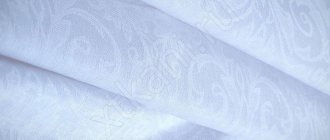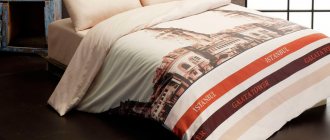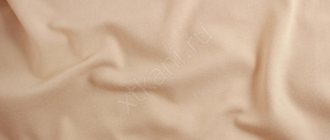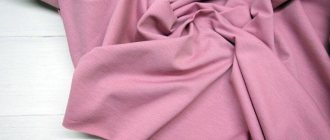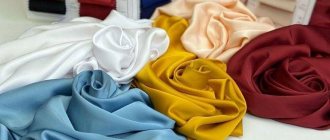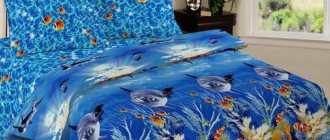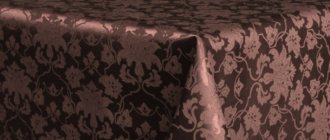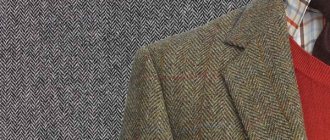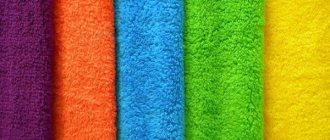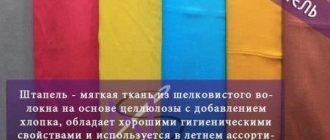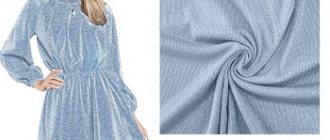Twill appeared in Scotland, where local residents were looking for a way to protect themselves from the piercing sea wind and cold. The development of weaving production has led to the emergence of a material with heat-saving and wear-resistant qualities.
Tweel has long been a name for fabrics that are dissimilar to each other and have a characteristic weave of threads. Now twill is a mixed material that combines the practicality and properties of natural and synthetic fabrics.
A little history
Twill has been used for several centuries. His homeland is Scotland. The first mentions date back to 1830 and are associated with an incident. The events were described by the Duke of Windsor in his memoirs, Remembering Windsor.
According to the text, an English merchant received new material from Scotland. It was accompanied by a description in which the unusual fabric was referred to as twill. Through inattention, the merchant read “tweed” (already known in those days) and launched the new product to the masses under this brand.
The confusion between twill and tweed fiber still exists today: they are indeed similar.
Throughout its history, the fabric has undergone many experiments: from variations with raw materials to playing with production methods. Initially, natural cotton threads were used as the basis for weaving. With the rise of synthetics, the possibilities for using fibers have expanded significantly.
In the 21st century, twill is often a mixed material.
Advantages and disadvantages
Pros:
- Breathing.
- Wear-resistant.
- Pleasant texture, recognizable “pattern”.
- Keeps its shape and does not wrinkle easily.
- Doesn't fade, doesn't fade.
- Easy to sew, mend, darn.
- A universal companion to any fabric.
- Protects from wind, moisture, and traps dust.
Minuses:
- It drapes poorly, does not form folds, and cannot be pleated.
- Labor-intensive to care for, difficult to clean and iron.
- If washing instructions are not followed, thin twill may warp and twist.
- Due to the fact that the fabric has a face, a back, and a pattern, it is not easy to cut, you need to adjust the details, following the pattern.
Composition and varieties
Twill is made from cotton, silk, polyester, elastane, and various combinations of them.
Based on the raw materials, the following popular types of this fabric are distinguished:
- twill-satin, or cotton type. Ideal for sewing light summer clothes. Cotton fibers provide maximum breathability.
- Twill-stretch, in other words - silk look. The most common composition of such fabric is: 98% cotton and 2% elastane. The percentage of raw materials can deviate in one direction or another by up to 3 units. Thanks to a small proportion of elastane, the products stretch better and do not wrinkle. This type of twill is widely in demand in light industry.
- Mixed or mixed type. This option is a combination of cotton (occupies from 30 to 97%) and synthetics. Of the artificial components, polyester is the most popular. Mixed fabric is actively used in sewing workwear, suits and uniforms.
The last two varieties are more affordable. Artificial fibers especially reduce the cost of production.
What's included
In accordance with the type of fibers used, a new type of fabric is made with the desired purpose:
- Silk threads with the addition of elastane (5%) make a beautiful fabric. Twill silk is used to make rich robes, bedspreads, stage outfits and home textiles.
- Cotton satin weave fabric is used in light clothing. It is called twill-satin. Trousers, shorts, jackets, breeches protect from the heat, give coolness and comfort. However, this fabric lacks elasticity.
- Twill stretch is elastic and pliable. Consists of cotton and stretch (3-5%) fiber. Properties: wear resistance, smoothness and excellent fit. Skirts, dresses, trousers and suits are made from it.
- The mixed variety of twill is represented by a variety of fabrics made from natural and synthetic components. The standard technique is two-thirds polyester and one-third cotton fiber. The result is a dense, durable fabric that looks elegant and attractive. A material with an equal ratio of cotton and polyester is considered high quality. Cheap textiles contain less than 35% cotton, which negatively affects breathability and hygroscopicity. Some manufacturers add viscose to the fabric. The material becomes soft and pliable, but loses strength.
Mixed twill is used for workwear for security guards, law enforcement officers, and technical personnel. Twill suits, with a predominance of synthetic fibers, are endowed with all the necessary properties for sewing casual suits for women and men.
Branded silk twill scarves and scarves are prized. In the 30s of the last century, fashionistas wore a square scarf called a “bob”. Famous fashion houses still produce stylish accessories.
Twill properties
The fabric is characterized by a textured surface, sometimes with barely noticeable knots. The smoothness and noble shine are remarkable. The special weaving method gives the fabric many advantages, regardless of its composition.
Advantages of twill products
- Strength and wear resistance. This characteristic makes the material stand out against the background of satin or twill.
- Density.
- Softness. The peach effect makes twill pleasant to the touch and comfortable to wear.
- Light drape.
- High breathability. The body "breathes".
- Dustproof. By allowing air to pass through, the canvas keeps dirt on the outside.
- Not susceptible to deformation. Twill is not deformed: it does not wrinkle, does not break, does not stretch or shrink.
- Resistance to sunlight. Clothes do not fade.
- Not susceptible to fungus and moths.
- Ability to dry quickly.
- Easy to care for (wash, dry, iron, store). The cotton type is especially unpretentious.
- External attractiveness and neatness.
Minuses
Twill has practically no disadvantages. But it is worth noting that:
- synthetic fibers in the structure can be harmful to allergy sufferers;
- the cotton type has insufficient elasticity and a high price.
Features of origin and production
The first samples of twill were made exclusively from sheep's wool without any additives. Natural fabrics warm well, but they shrink a lot after washing. Thick threads of dark gray and brown shades gave the material an unusual texture. The heavy textured fabric was different from modern fabrics.
Under the influence of fashion and the emergence of new yarn production technologies, the fabric gradually changed. She changed not only externally, but also to the touch. Now more than two dozen different materials are combined under the name twill.
This may interest you Which fabric to choose instead of velvet: which material will be simpler
Application area
The material is in demand in the production of all kinds of men's, women's and children's wardrobe items for all seasons, accessories and more. The following are sewn from twill fibers:
- items to be worn in warm and summer months (trousers, shorts, skirts, dresses, T-shirts, shirts, etc.);
- winter and demi-season outerwear (jackets, raincoats, etc.);
- linings;
- home textiles (curtains, bedspreads, blankets, furniture upholstery, tablecloths, napkins);
- bed sheets;
- uniforms for various purposes, medical clothing, school uniforms;
- hats;
Thick twill is well suited for creating professional clothing. A thinner one is for sewing bedding and summer clothes.
Where is it used?
The scope of its application is extensive. Twill is used for sewing bed linen, trousers, special and professional clothing. Allows for slight addition of impurities in the composition. The scope of application depends on the latter. The thickest fabric is used for sewing professional clothing. It allows air to pass through well, while retaining dust and is durable and wear-resistant.
A thinner option would be ideal for bed linen. It does not wrinkle and has an attractive appearance. This bed linen will be a good option for both summer and winter. It warms well and absorbs moisture. These are ideal qualities for any time of year.
Care instructions
Although the fabric is not difficult to use, there are a certain number of rules. They should be adhered to so that things last a long time and do not deteriorate.
- Twill satin can be washed at maximum temperatures with any detergent.
- You need to be careful with other types of fabric. Washing mixed items is permissible at a temperature not exceeding 40 degrees. Bleach and aggressive detergents are prohibited in this case.
- It is advisable to use conditioner to preserve structure and color.
- Drying in direct sunlight is not recommended.
- It is advisable to iron the item while damp.
When purchasing a new item made from this fabric, be sure to read the attached instruction manual.
Cost, what prices depend on
The cost of the material depends on its composition, production method, and the name of the factory. Samples imported from abroad are more expensive than domestically produced material. The price is influenced by the markup that the retailer sets to make a profit.
You might be interested in How to make fabric waterproof using water-repellent impregnation
| Type of fabric | Synthetic impurities | Natural fiber | Price |
| Twill twill | Polyester - 50% | Cotton - 50% | 150-200 rub.* |
| Country of origin Russia | 35 % | 65 % | 350-400 rub. |
| Country of origin: China | 35 % | 65 % | 380-420 rub. |
| For workwear | 100-150 rub. | ||
| Furniture fabrics (China) | 300-450 rub. | ||
| Wool tweed (Italy) | 2000-3000 rub. | ||
| Suit fabric(Italy) | 5 % | 50% wool, 45% silk | 3500-4000 rub. |
Advantages of twill
- Comfort. The material is soft and delicate, pleasant to wear.
- Doesn't wrinkle. A very important advantage is that you don’t have to worry about losing its shine or losing its shape during long-term use.
- Resistant to washing even in hot water: the material will not stretch or shrink.
- Applicable in any weather: in cold weather it will warm you up thanks to its air exchange properties.
- Dust and dirt are not allowed to pass through the fabric. The body will always remain clean, only the material will become dirty.
- Hypoallergenic. The matter consists of natural materials, therefore it does not cause protective reactions of the body. Pleasant to the body, this fabric calms the wearer, gives confidence and tones.
- Dries quickly and washes well. If you need to dry the fabric quickly, you can use an iron, which will not cause any harm to the fabric.
- A variety of colors for products made from this material. If previously the choice of colors was scarce, now it is difficult not to find a suitable color.
- It can be worn for many years without losing its appearance. You just need to follow simple rules of care.
- Practicality. This material is suitable for any event: official or everyday.
Once I washed a twill blouse in hot water - I accidentally forgot to switch the mode in the washing machine. I thought the item would be thrown away, but it turned out not. The blouse remains in good condition, now I try to look at the fabric from which the clothes are made and choose twill.
Vika
Features of fabric weaving
Twill is formed by a diagonal weave, which is also called twill or keeper. The base is twisted natural or mixed fibers. Such canvases are produced on special machines. Externally, they are distinguished by a characteristic relief surface in the form of a large or small diagonal scar, which is easy to notice. The intensity of the tilt depends on the properties of the threads used: their thickness, density and twisting characteristics. Thanks to this weave, twill is wear-resistant and not subject to physical impact.
- The fabric can be dyed well with various dyes, the colors are durable and do not fade over time. Thanks to its structure, twill often drapes perfectly.
Manufacturing technology
At first, the material was made from 100% natural wool. The threads used were dark and dense. The texture of the fabric, unlike others, attracted buyers. Soon cotton or silk threads began to be added to woolen threads. This expanded the use of the material: now it was possible to make handbags and outerwear from it. Today, twill fabric, the description of which, at first glance, is simple, consists of two or more fibers. Depending on the ratio of threads, varieties are distinguished:
- Polysatin. The composition of this material is no less than 35% cotton and no more than 65% polyester. This material is more durable and beautiful.
- Tweed. Consists of wool and polyester with different percentages.
- Silk twill. Expensive and high-quality clothes are created from this material. To improve quality, 3% elastane is added. Compared to satin, this twill uses more silk, so it is more expensive. Lately, cloth linen has been in demand.
- Satin. The difference from other types of satin lies in certain proportions of cotton and satin in the composition of the material. The material differs from ordinary satin in its lower density, but this fact in no way detracts from the advantages of the fabric. This material wrinkles slightly and is quite difficult to smooth out.
I like high-quality and comfortable clothes, but elegance and attractiveness have not been canceled. I try to choose silk twill, which is of excellent quality. Yes, the price is slightly more expensive than clothing made from other fabrics, but the wearing comfort is much higher.
Alex
Photo gallery
Fabrics for blouses Fabrics for trousers Fabrics for upholstery of sofas Fabrics for upholstery of armchairs Fabrics for upholstery of chairs Fabrics for blankets Fabrics for blankets Fabrics for pillows Fabrics for bedspreads Fabrics for bed linen Fabrics for shirts Fabrics for sundresses Fabrics for tablecloths Fabrics for shirts Fabrics for workwear Fabrics for T-shirts Fabrics for hats Fabrics for scarves Fabrics for curtains Fabrics for skirts2017-09-25
Tags: Fabrics for blouses Fabrics for trousers Fabrics for upholstery of sofas Fabrics for upholstery of chairs Fabrics for upholstery of chairs Fabrics for blankets Fabrics for blankets Fabrics for pillows Fabrics for bedspreads Fabrics for bed linen Fabrics for shirts Fabrics for sundresses Fabrics for tablecloths Fabrics for shirts Fabrics for workwear Fabrics for T-shirts Fabrics for hats Fabrics for scarves Fabrics for curtains Fabrics for skirts
Back Chenille
Forward Polyester
You might be interested
What standards are used in production? What do they take into account?
Twill production is regulated by Russian GOSTs for the textile industry:
- 11209-85 “Cotton and blended fabrics for workwear”, which states that for every 10 cm of fabric area for a future protective jacket there should be strictly 291+/-4 warp threads and 135+/-4 weft threads.
- 29223-91 “Fabrics for dresses, dress-suits and suits made from chemical fibers” establishes the percentages of natural thread and synthetics: 65% polyester and 35% cotton; 65% wool, 30% viscose and 5% acrylic; 10% viscose, 25% cotton and 65% polyester - synthetics lighten the weight of the fabric and prevent shrinkage.
- 29298-2005 “Cotton and mixed fabrics” allows the use of threads with small knots, giving the fabric an elegant casualness and rusticity.
How much does the fabric sell for?
Cotton twill made in Bangladesh or Pakistan can be found for 600-800 rubles/m. An American one will cost 1200-1500 rubles and more.
Wool twill or wool with silk from European factories (Italy, Belgium, France) can be sold for 6000-8000 or more rubles/m.
The price of artificial fabric (100% polyester or a mixture with elastane) is from 350 to 700 rubles/m. Chinese twill (35% cotton, 65% polyester) - within 400 rubles/m.
It is unlikely that now you will confuse twill with tweed or will not be able to distinguish this fabric by touch. For every task there is a different type of this truly universal fabric, which any buyer will select according to the capabilities of his wallet.
What is twill?
Twill is a fabric made from natural fibers, wool or cotton, dense and soft to the touch. A special feature is its production: the threads are intertwined according to a special pattern. Externally, twill resembles denim. There is often confusion between the names "tweed" and "twill". Tweed is a fabric made from wool with a twill weave. The line between these two concepts is very blurry. Tweed is rather a twill material with a larger proportion of wool.
Reviews of twill fabric
Most buyers are satisfied with the properties of twill. Negative feedback can only be heard about fabrics with a high synthetic content.
Reviews about twill:
Alina:
I bought twill-satin bed linen, which won everyone's heart. Beautiful, inexpensive, pleasant to the touch, easy to care for. It retains its color after many washes, does not deform, and dirt is easily removed.
Marina:
I love silk twill skirts and dresses. They look very feminine and seductive. I wear these things in the warm season. The fabric is light, breathable, not hot, easy to wash, and dries quickly.
Anna:
I bought a cotton twill pantsuit. After a few wears I was disappointed in the set. It practically does not allow air to pass through, so I sweated, and when it got cold, the thing did not warm me at all. As it turned out, the ratio of cotton to polyester in the kit is 40:60%.
Flaws
Judging by most reviews and quality indicators, twill has very few disadvantages. It is only worth noting that:
- synthetics in the fabric may be contraindicated for allergy sufferers;
- The cost of cotton type fabric is high and its elasticity is insufficient.
Otherwise, twill is not inferior to other high-quality fabrics, and in many ways even surpasses them.
This can be judged by its popularity among ordinary buyers, private seamstresses and fashion designers.
Care of mixed materials
In the description of the material, manufacturers give recommendations for care:
- Twill can be washed frequently. It tolerates machine wash well.
- Before loading into the drum, things are folded into neat piles and distributed evenly.
- The water temperature should be between 30°C and 40°C.
- It is not advisable to use bleach. Liquid soft gels are best. They are evenly distributed in the compartment during washing, things can be easily rinsed from them.
- To keep the twill soft and pleasant to the touch, it is recommended to use conditioners when rinsing.
- Drying things in the open sun is not recommended; a place on a closed veranda or balcony is good for this.
Note! It is best to iron twill items when the fabric is still slightly damp. Over-dried items are difficult to iron and will have to be steamed or sprayed.
